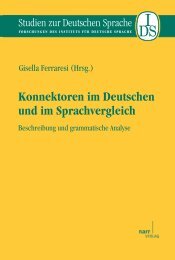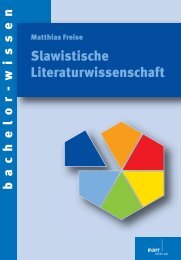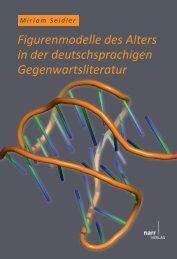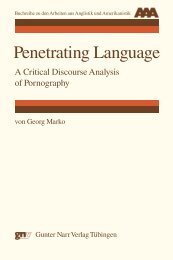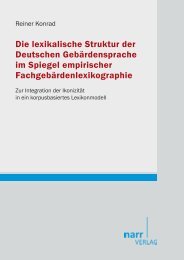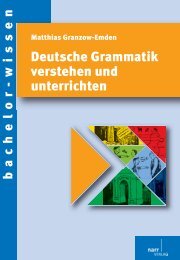Phraseologie. global - areal - regional - im Shop von Narr Francke ...
Phraseologie. global - areal - regional - im Shop von Narr Francke ...
Phraseologie. global - areal - regional - im Shop von Narr Francke ...
Create successful ePaper yourself
Turn your PDF publications into a flip-book with our unique Google optimized e-Paper software.
Common features in the phraseology of European languages: Cultural and <strong>areal</strong> perspectives 19<br />
across many languages (see section 4 below). The same holds for modern source domains of idioms<br />
such as sports (e. g. racing, boxing, and athletics). It remains unclear why there are equivalents<br />
of the idioms a race against t<strong>im</strong>e, to be on the finishing straight or to hit below the belt in 40<br />
or more languages, while idioms such as to be off the starting blocks or to clear a hurdle can be<br />
found at best in a dozen of languages.<br />
In order to ascertain widespread idioms, extensive groundwork has been done, relying on the<br />
assistance of experts of many languages. The WI data have been collected as follows: First, a list<br />
of about 1.000 potential WIs was compiled based on some prel<strong>im</strong>inary knowledge and later completed<br />
by systematic and large-scale studies, checking many publications on phraseology and<br />
idiom dictionaries. The starting point was not only some major “school languages” of Central<br />
Europe, but also included Finnish, Greek and Russian. The idioms then have been pre-tested by<br />
experts of further geographically and genetically diverse languages (Hungarian, Estonian, Latvian,<br />
Polish, Croatian, Bulgarian, Spanish and Romanian). The result was a remaining core set of<br />
about 400 actual “widespread idiom candidates” which then had to be reviewed for as many languages<br />
as possible.<br />
For this purpose a network of competent collaborators has been built up and questionnaires<br />
with the “WI candidates” were sent via e-mail to many native speakers and linguists, covering<br />
more than 80 languages and asking addressees to answer the questions based on both their own<br />
competence and discussions within their circle of colleagues. The questionnaires were filled in<br />
carefully for the most part. Several participants have verified their information via text corpus<br />
analyses or investigations on the Internet. For several minor and minority languages, these resources<br />
did not exist, neither was it possible to refer to idiom dictionaries. In these cases the informants’<br />
answers were a particularly valuable and a unique source.<br />
4 Cultural foundations of widespread idioms<br />
At the t<strong>im</strong>e of this writing, the surveys have produced a total of 330 items that fulfill the criteria<br />
of widespread idioms. The main question of the cultural domains that the WIs belong to can now<br />
be answered more precisely. Idioms that are really widespread across the languages of Europe and<br />
beyond can be categorized according to their cultural foundations. For this purpose, the distinction<br />
between a synchronic and a diachronic (etymological) level of analysis can be left aside. This<br />
means that the set of widespread idioms can be structured, for the most part, according to the<br />
underlying etymological and cultural features. Quantitative aspects of the cultural foundations<br />
have also emerged. Five main parts can be distinguished and divided into 19 smaller groups, even<br />
though they tend to overlap and interrelate. We will give a short overview.<br />
Part I: Intertextuality<br />
The greatest part, with 173 items almost half of the entire inventory of WIs, is made up of idioms<br />
that belong to the cultural domain of intertextuality. Idioms of this kind have an already existing<br />
(mostly identifiable) text as their sources. 7 The inventory clearly shows which works of literature<br />
and which details of passages in a text have led to widespread idioms and which ones have not.<br />
The WIs discovered so far are distributed, in varying numbers, over seven groups of sources of<br />
text passages:<br />
7 It is beyond the scope of this article to go into the term intertextuality in detail. Phraseology researchers use it with<br />
different meanings. Burger (1991) applies it to the availability of pre-fabricated text fragments (aphorisms, slogans,<br />
book titles etc.) and their interweaving in a text, while paremiologists understand it in the sense of the interrelation between<br />
proverbs and narrative texts (cf. Carnes 1994). Intertextuality is even seen as a constituent element or definition<br />
criterion of the proverb (Bauman/Briggs 1990; Winick 2003, 589).





